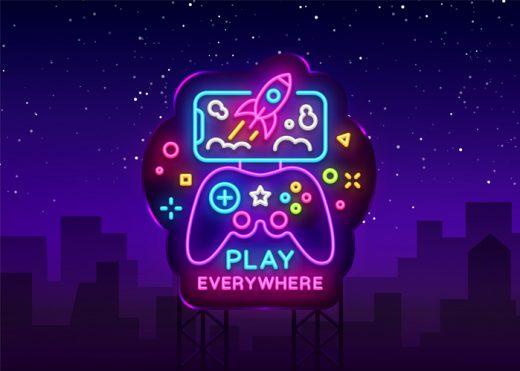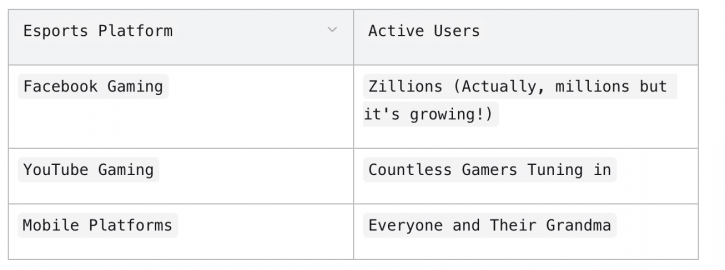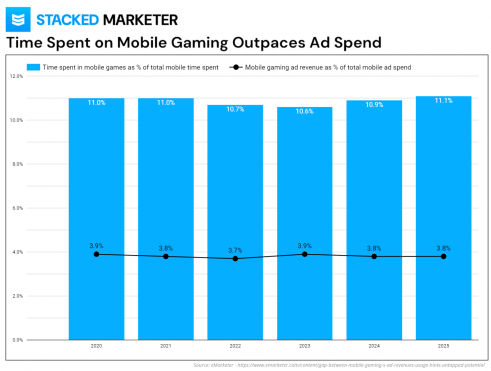Are you ready to dive into a world of video game advertising like a caffeinated squirrel on an energy drink? Buckle up because we’re about to explore the exhilarating realm of video game advertising and how it’s evolving with mobile platforms.
With esports on the rise and our phones becoming supercomputers in our pockets.
The fusion of mobile gaming’s explosive revenue ($184 billion in 2023) and the complexity of player engagement, especially in games like Madden NFL Mobile, offers brands a chance to level up their marketing in ways that might not seem obvious at first.
Gamers are no longer just players; they’re fans, influencers, and, let’s face it, digital currency-spending machines – perfect candidates for the latest ads trying to snag their attention.
So grab your controller, and let’s load up on knowledge about the captivating future of video game advertising!
The Evolution of Mobile Marketing: Where Gaming Meets Growth
Mobile esports is leveling up faster than a speed-run through a “Super Mario” level. The landscape of mobile marketing has seen rapid changes, and it’s no longer just about reaching consumers through standard ads on smartphones.
With the explosion of mobile gaming, brands now have a new arena to tap into. Mobile gaming represents nearly 50% of global gaming revenue, and its influence continues to expand.
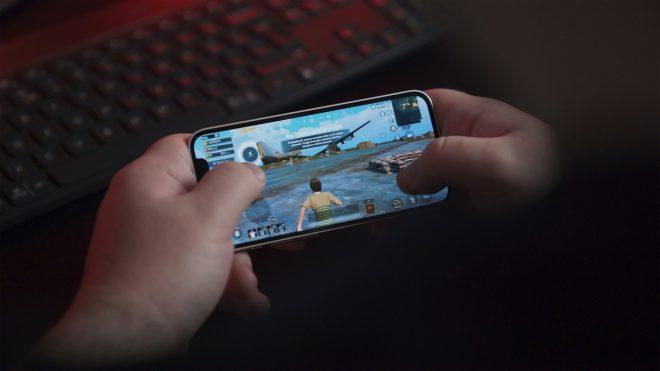
Designed by Freepik
Who knew your smartphone would become the gateway to gaming glory? With the surge of popular games on-the-go, the mobile gaming industry is swatting away console games like a retro arcade boss.
Today’s gaming community doesn’t want to be tethered to the TV—they’d rather swipe to victory on the morning commute.
Why so popular, you ask? Casual games are anyone’s game. They’re simple enough for your pet hamster to understand but addictive enough to keep the gaming experiences fresh and engaging.
Let’s not overlook the marketing opportunities: banner ads, in game ads, and video ads.
So, grab your phone and join the revolution—mobile esports isn’t just hitting the high scores; it’s changing the game, no cheat codes required.
Gaming: The New Multiplayer Water Cooler
Video games, particularly multiplayer and social games, are now the digital hubs where people connect. 88% of gamers use games to form friendships, making it a prime opportunity for brands to insert themselves into these power-ups of social interaction.

Designed by Freepik
Sponsoring branded virtual tournaments or custom in-game items isn’t just pressing start on a traditional ad—it’s becoming part of the action.
Understanding the Player-Fan Phenomenon
Understanding the Player-Fan Phenomenon is like decoding the love language between gamers and their digital crushes – aka their favorite games.
In the gaming sphere, players don’t just mash buttons; they form a bond stronger than super glue with their pixelated partners.

Designed by Freepik
Key Points:
- Players become not just fans, but loyalists, evangelists, and defenders of their cherished titles.
- Emotional attachment drives engagement – it’s more “till death do us part” and less “just playing.”
- This connection fosters an interactive community, where player feedback often shapes game development.
The Upshot:
- Fan input is crucial for game developers – think of it as free, heartfelt consulting.
- Popular games aren’t a fluke; they’re the offspring of player passion and developer dedication.
- A dedicated fan base is the ace up a developer’s sleeve, turning casual games into legendary titles.
This close-knit relationship boosts user experience and ensures that the video game industry keeps rolling out adventures that thrill our digital hearts.
Players and fans don’t just game – they live the game. And in this loving gaming family, every error message is just a new conversation starter.
In-App Purchases and Advertising: The Real High Score for Brands
Alright, put on your coin-collecting overalls, we’re diving into the treasure trove that is monetization in the wicked world of mobile games.
Now, the gaming industry isn’t just pumping out adorable angry birds, there’s a crafty game plan behind it all—cha-ching!
So, how do these devious devs make their pockets jingle with each swipe and tap?
Find more statistics at Statista
While many brands are still chasing influencers and social ads, in-game purchases are the hidden Easter eggs of revenue potential.
These micro transactions are forecasted to hit $74 billion by 2025, and brands can partner with gaming companies to create branded content—think custom skins or power-ups that link to real-world rewards.
It’s less about spamming banner ads and more about unlocking achievements in integrated marketing.
In-App Purchases
Enter the realm of In-App Purchases, where players can deck out their digital avatars with swanky gear faster than you can say “Take my money!”
It’s like being on a shopping spree without moving from your couch. These are the shiny trinkets and magical power-ups in your favorite mobile games that can take your gaming experience from meh to marvelous—assuming you’re willing to part with the dough.
Here’s how it pans out in our beloved virtual arcades:
- Virtual currency: Because carrying coins is so 1990s, games offer fancy gems, gold or even ‘berries’ you can stockpile.
- Power-ups and boosts: Why grind when you can glide? Skip the wait and power-up instantly, because patience is for chumps (apparently).
- Subscriptions: Get the VIP treatment! Regular perks and pats on the back, all for the price of a daily designer coffee.
Think of In-App Purchases like a gaming buffet. You can nibble on the free stuff, but oh, the good stuff is behind that sneaky little paywall candy. And who can resist candy?
Breaking Out of the Console Silo
Mobile may dominate, but it’s not the only platform that matters. Cross-platform gaming is on the rise, and players who game across mobile, PC, and console spend more.
Brands that recognize this can go multi-player with campaigns across devices, ensuring they’re part of the main quest whether consumers are playing on their commute or at home.
Ignoring this cross-play trend is like missing out on the boss fight for consumer engagement.
Indie Games: The Underdog That Levels Up Niche Marketing
While blockbuster titles dominate the headlines, indie games are winning the hearts of a dedicated and growing audience. These smaller games are often rich in unique stories and emotional engagement.
For brands with niche products or strong storytelling, sponsoring indie games is a way to connect authentically with passionate gamers.
Supporting these underdogs means aligning with creativity and innovation, giving brands the chance to be the hero for small studios.
Twitch Is the New Arena: Watch the Play, Win the Game
The gaming audience isn’t limited to just players.
Millions of people now watch games on platforms like Twitch and YouTube Gaming. With 2.86 billion hours watched on Twitch in 2023 alone, brands can tap into this audience by sponsoring influencers or creating their own content.
This is an untapped market that’s ready to play for brands.
Brand Integration within Games
Here’s where things get juicier than an in-game health potion. Brand integration within games is like seamlessly weaving a magic carpet of brand presence into the fabric of gaming experiences.
Picture a tumble of basketballs that magically bear the logo of a sports brand in a free-to-play game, or a quest where your character raids a dungeon sponsored by a trendy energy drink.
This isn’t just throwing banner ads at players and hoping they’ll click; it’s about integrating the brand into the very essence of the game.
A character might use a gadget that looks suspiciously like the latest tech on the market, or a storyline might pivot around events that mirror a brand’s campaign.
When done right, it feels less like an ad and more like a natural part of the game’s world—so players keep on playing, and brands become as beloved as the games they’re playing within.
In conclusion, get ready to uninstall the idea of intrusive, yawn-inducing ads, and download the next-gen tactics of immersive, engaging, and downright wizard-level sponsorship strategies.
Weave these into your marketing playbook, and you’ll have users so engaged, they’ll swear they’re stuck in a game—even when they’re just browsing their social feeds!
Measuring Success with Key Performance Indicators (KPIs)
Dive into the deep dark depths of analytics – don’t worry, it’s more party than parley. Key Performance Indicators (KPIs) are the high scores of the marketing world, showing you if your brand’s dance moves are setting the floor on fire or if they’re more of a ‘dad at a wedding’ vibe.
Picture a dashboard glittering with numbers – these are the cheat codes to understanding if your marketing mojos are working. It’s about knowing which levels you’ve nailed and where you’re still eating digital dust.
Engagement Metrics
Like counting the laughs per joke at a stand-up show, Engagement Metrics measure how well your brand is mingling with the gaming crowd.
We’re spying on things like how often gamers are high-fiving your in-game ads and whether they’re taking your virtual branded power-ups for a spin more than once.
Engagement metrics are like a round of applause for your brand. They can range from the number of likes and shares on social platforms to the heat maps of where players are touching their screens the most (hopefully not just to swipe away those pesky banner ads!).
It’s about answering questions like: Do they love us? Do they really, really love us?
Conversion Rates
Curtain up on the star of the show: Conversion Rates. This tells you if your seductive in-game ads make gamers weak in the knees and trigger happy on the ‘buy’ button.
Imagine your game as a carnival booth – conversion rates let you know how many folks are walking away with a giant teddy bear after seeing your pitch.
Your conversion rate is that smug grin you give when you know you’ve got ’em hooked.
Brand Awareness Tracking
Knock knock! Who’s there? Your brand, tip-toeing into the mind of every player out there!
Brand Awareness Tracking is like the breadcrumb trail you follow to realize how many folks in the gaming universe are whispering your name in awed tones around the virtual cooler.
This is the stealthy ninja of metrics, calculating everything from how many times your brand gets Googled post-gameplay to the surge in followers on your Instagram after that killer in-game event.
Remember, these KPIs are the power-ups you need to make sure your video game sponsorships are collecting coins rather than cobwebs. So equip your brand with the right data shield, and watch those numbers level up!
The Demand for Authenticity in Sponsorships
Here’s the hard truth: authenticity matters. It’s the secret sauce of successful partnerships in the gaming industry, right up there with a cheat code.
Authenticity Checklist:
- Gamer-Centric Approach: Does the sponsorship put the gaming community first? Because nothing says “we care” like tailoring experiences weirdly in sync with those joystick junkies.
- Relevance: If a basketball game sponsors a tofu brand, it’s a miss. Stick to relevant, nirvana-like pairings that make gamers shout, “That’s more like it!”
- Transparency: Gamers have got eagle eyes. They spot a sneaky, inauthentic deal faster than you can say, “Electronic Arts.” Honesty is the best policy.
In the end, the demand for authenticity in sponsorships is as high as the scores on a Mobile Game Maker leaderboard. It’s the cornerstone of getting those sweet nods of approval from the very discerning, ever-enthusiastic legions of thumb warriors in the mobile gaming realm. Keep it real, and you win the game!
Future Trends in Mobile Game Sponsorships
Oh, the future of mobile game sponsorships, it’s like trying to predict the next big TikTok dance craze – but with more pixels and probably fewer sprained ankles. So, let’s put on our virtual reality goggles and look ahead!
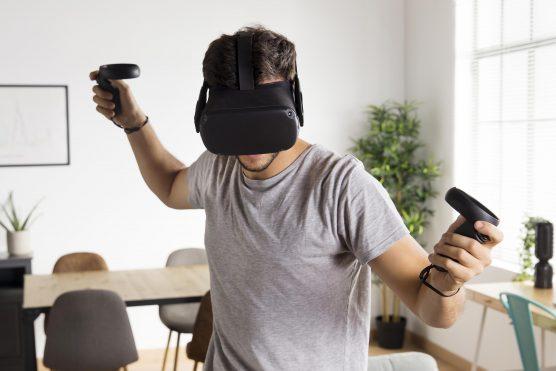
Designed by Freepik
Trend Spotting: The Digital Forecast
- Micro-Influencers FTW: Game dev folks are eyeballing the “less Kardashian, more Kev from down the block” approach. These micro-influencers have niche followings like a koala has a taste for eucalyptus – very specific and very dedicated.
- Cross-Pollination Extravaganza: We’re not talking about bees here, but the buzz is all about crossing over. Think your favorite casual game popping up in a basketball game halftime show. Mashups galore!
- Playable Ads Leveling Up: Those pesky banner ads are so last level. Upcoming are interactive video ads that let you test-drive a game faster than you can say “Wizards Unite!”
- Everlasting Events: Those one-off events? Pfft. Continuous, integrated sponsorship shindigs within gaming experiences are becoming the new norm. A wedding in a game, sponsored by a real-life cake company? Why not?
- Chit-Chats and Streams: Social platforms like Twitch and YouTube Gaming are the new watercoolers. Interactive live streams with gamers and sponsors are turning passive watchers into active users and chatty Cathys.
With these trends, the mobile game sponsorship scene is shaking up like a snow globe post-earthquake, providing endless marketing opportunities for every savvy game developer and Mobile Game Maker there is. Console games, watch your back – mobile is on the move!
Conclusion: The Final Boss—The Future Is Gaming
Sponsoring video games isn’t just a side quest—it’s the final boss in a world where gamers are consumers who want their brands to be part of their experience.
The future of marketing lies in leveling up through integrated in-game sponsorships that enhance the user experience.
If you want your brand to truly connect with a global audience? Sponsor gaming ads now and connect your brand with engaged players worldwide!
